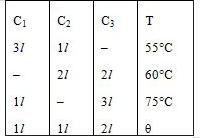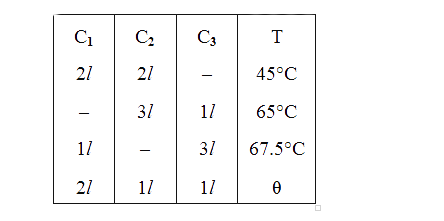Three containers C1,C2andC3 have water at different temperatures. The table below shows the final temperature T when different amounts water (given in liters) are taken from each container and mixed (assume no loss of heat during the process)

The value of θ (in .∘C to the nearest integer) is ------------
The correct Answer is:50
Step by step video & image solution for Three containers C_(1), C_(2) and C_(3) have water at different temperatures. The table below shows the final temperature T when different amounts water (given in liters) are taken from each container and mixed (assume no loss of heat during the process) The value of theta (in .^(@)C to the nearest integer) is ------------ by Physics experts to help you in doubts & scoring excellent marks in Class 12 exams.
Similar Questions
Three containers C1,C2andC3 have water at different temperatures. The table below shows the final temperature T when different amounts of water (given in litres) are taken from each containers and mixed (assume no loss of heat during the process)

The value of θ (in ^(∘)C to the nearest integer) is …….View SolutionThree containers C1,C2andC3 have water at different temperatures. The table below shows the final temperature T when different amounts of water (given in litres) are taken from each containers and mixed (assume no loss of heat during the process)

The value of θ (in ∘C to the nearest integer) is.......View Solution
Knowledge Check
- Question 1 - Select One
The isothermal diagram of a gas at three different temperatures T1,T2andT3, is show in the given figure .Then
 Aa.T1<T2<TBb. T1<T2>T3Cc.T1>T2>T3Dd.T1>T2<T3
Aa.T1<T2<TBb. T1<T2>T3Cc.T1>T2>T3Dd.T1>T2<T3 - Question 2 - Select One
One gram of water at 100∘C is converted to steam at the same temperature. The amount of heat required is nearest to the value of
AzeroB336 JC540 JD2257 J
Three containers C1,C2 and C3 have water at different temperatures. The table below shows the final temperature T when different amounts of water (given in litres) are taken from each containers and mixed (assume no loss of heat during the process)

The value of (in °C to the nearest integer) is …….View SolutionFigure shown two adiabatic vessels, each containing a mass m of water at different temperature. The ends of a metal rod of length L, area of cross section A and thermal conductivity K, are inserted in the water as shown in the figure. Find the time taken for the difference between the temperature in the vessels to become half of the original value. The specific heat capacity of water is s. Neglect the heat capacity of the rod and the container and any loss of heat to the atmosphere.
 View Solution
View SolutionThe temperature inside a refrigerator is t2 C and the room temperature is t1 C. The amount of heat delivered to the room for each joule of electrical energy consumed ideally will be
View SolutionThe initial and final temperatures of water in a container are observed as 16±0.6∘C and 56±0.3∘C. What is the rise in the temperature of water.
View Solution200 g of hot water at 80∘C is added to 300 g of cold water at 10∘C. Calculate the final temperature of the mixture of water. Consider the heat taken by the container to be negligible. [specific heat capacity of water is 4200 Jkg−1∘C−1]
View SolutionThree perfect gases at absolute temperature T1,T2,andT3 are mixed. The masses of molecules are n1,n2andn3 respectively. Assuming to loss of energy, the final temperature of the mixture is:
View Solution

